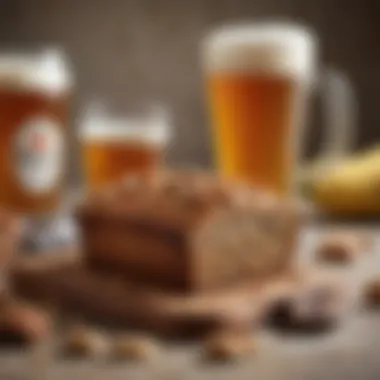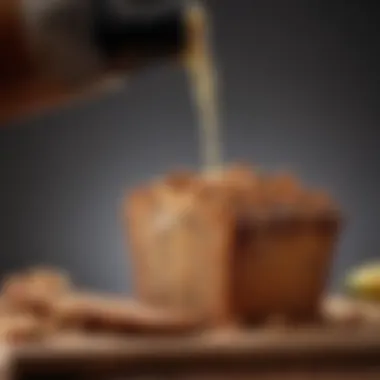Exploring the Unique World of Banana Nut Bread Beer


Intro
The delightful marriage of banana nut bread and beer is not only a treat for the palate but also a true testament to the adventurous spirit of the modern craft brewing scene. Infusing this comforting and often nostalgic baked good into beer is an alchemy of culinary creativity that celebrates flavors often reserved for breakfast or coffee breaks. As craft brewers look to push boundaries, banana nut bread beer emerges as an exciting exploration of taste, fermentation, and innovation.
This article takes you on a journey through the subtleties and complexities of banana nut bread beer. We will dissect the essential ingredients, brewing techniques, and the delicate balance that gives this brew its unique character. Also, we will explore how cultural influences and consumer preferences have shaped its growth in popularity, rendering it more than just a trend but a viable addition to any craft beer enthusiast's rotation.
Here, you will discover that banana nut bread beer isn’t just a novelty drink; it opens doors to various culinary applications and serving suggestions that can elevate a dining experience.
Recipe Overview
Recipe Name
Banana Nut Bread Beer
Description of the Dish
This beer is a homage to the beloved banana nut bread, characterized by a rich, fruity aroma and nutty undertones. The malt base often mirrors the doughy sweetness of the bread, while the use of real bananas during the brewing process delivers a delightful, natural flavor. Hints of cinnamon and nutmeg can often be detected, reminiscent of freshly baked banana nut bread cooling on the kitchen counter. Whether enjoyed on its own or paired with complementary dishes, this brew offers a wonderful taste of home baked goodness in every sip.
Ingredients
List of Ingredients with Measurements
- 5 lbs Pale Malt
- 1 lb Munich Malt
- 1 lb Wheat Malt
- 1 lb Ripe Bananas (around 4 medium bananas)
- 8 oz Chopped Walnuts
- 1 oz East Kent Goldings Hops
- 1 packet of Ale Yeast
- 2 teaspoons Cinnamon
- 1 teaspoon Nutmeg
- 5 oz Brown Sugar (optional, for additional sweetness)
Special Notes on Ingredients
- Bananas: Ideally, use overripe bananas for maximum sweetness and flavor. Some prefer to roast the bananas before addition to echo the toasty notes of baked bread.
- Walnuts: They can be replaced with pecans or almonds for a slight twist in flavor.
- Hops: While East Kent Goldings is traditional, consider using a mild hop variety to avoid overpowering the delicate banana flavor.
"The golden rule is to always taste as you brew. Each batch might tell a different story."
Understanding these elements will not only enhance the brewing experience but will also provide insight into how each component contributes to the final flavor profile. Craft brewing is about experimentation, and banana nut bread beer opens up a world of possibilities, both in flavor and in culinary pairings.
Understanding Banana Nut Bread Beer
Banana nut bread beer represents a fascinating blend of two culinary worlds—baking and brewing. The combination may seem unconventional at first, but it presents a delightful exploration into flavors and brewing methods. Understanding this unique intersection is essential for any food enthusiast eager to dive deeper into contemporary gastronomy. The appeal of this beverage lies in its ability to bring together familiar tastes in unexpected ways, allowing brewers and home enthusiasts alike to craft something that tantalizes the palate while paying homage to beloved comfort food.
Origins and Historical Context
The roots of banana nut bread beer could very well stretch back to the golden days of brewing when home cooks and artisans began experimenting with local produce. The history is less about specific documentation and more about a shared journey through taste. As bananas became increasingly available, notably in regions that had maritime trade routes, their incorporation into baking began to emerge.
In the United States, the popularity of banana nut bread surged during the Great Depression, a time when resourcefulness was crucial. Ingredients were used up fully, and overripe bananas found new life baked into nutty loaves. This recipe showed resilience, leading to modern iterations blending this classic with beer.
"Banana nut bread beer is more than just a novelty; it tells a story of culinary adaptation, cultural exchange, and the quest for flavor."
Cultural Significance of Banana Flavors
Bananas are not just any fruit; they carry a fusion of cultural meanings and sweet nostalgia. They remind many of tropical landscapes and simple childhood delights, making them an integral part of desserts across various culinary traditions. When breweries began to experiment with banana flavors, they tapped into a rich source of emotions and memories, transforming ordinary brews into experiences.
Moreover, the flavor of bananas often evokes warmth and comfort, reminiscent of time spent in kitchens where loved ones baked together. Adding this to beer expands the boundaries of what people expect when enjoying a pint. It connects not only to flavor nostalgia but also to a culture of innovation, pushing the envelope on traditional brewing practices.
The Evolution of Flavor Combinations
The journey of flavor combinations in brewing has shifted significantly through the years. Originally, brewers tended to stick to classic ingredients: hops, barley, and water. But nothing is set in stone. As craft beer gained traction, adventurous brewers started to marry unusual elements, leading to the rise of dessert beers like the banana nut bread variant.
Through this evolution, banana and nut pairings emerged as a response to consumer taste and curiosity. Brewers began experimenting with various nuts such as walnuts or pecans, creating layers of complexity.
Now it's not just about beer anymore; it’s about creating a multi-sensory experience where flavors harmonize. Hence, we've seen banana nut bread beer stepping into the spotlight, offering a distinctive taste that caters to those looking for something beyond the ordinary. As this particular flavor combination grows in popularity, it’ll be intriguing to witness how it continues to evolve, becoming a staple for the adventurous brewing community.
Understanding these intricate ties helps appreciate not just the beverage itself but the broader cultural narratives that accompany this invention, making it a marvel worth savoring.
Components of Banana Nut Bread Beer
The crafting of Banana Nut Bread Beer necessitates a solid understanding of its core components. This section delves deep into the vital ingredients that coalesce to create this unique brew. Each element—bananas, nuts, malts, hops, and sugars—plays a significant role, significantly influencing not just the flavor profile, but also the texture and aroma of the beer. The balance among these components is key to achieving a final product that reflects the comfort of banana nut bread while offering the refreshing qualities expected from beer. Therefore, knowing how these ingredients contribute to the brewing process, fermentation, and eventual taste is crucial for anyone looking to either brew their own or simply appreciate this distinctive beverage.
Primary Ingredients
Bananas as a Brewing Ingredient


Bananas, the star of this fusion, bring a myriad of complexities to the table. Their natural sugars not only add sweetness but also invoke a slight creaminess that mirrors the experience of eating banana bread. As they mature, bananas develop a rich flavor that is both aromatic and functional. When used thoughtfully in brewing, they can enrich the beer with hints of vanilla and even introduce some pleasant esters that enhance the aroma.
However, there is a catch. Not all bananas are equal in the brewing world. Overripe ones work wonders since their starch converts perfectly into sugars during the fermentation process. Using fresh bananas is not as effective and may lead to an unbalanced flavor.
Nuts in Beer: Flavor and Texture
Nuts bring texture to the game—think about the crunch in a loaf of banana nut bread. The likes of walnuts or pecans can offer delightful earthy notes and nuttiness that enhance the experience. More than just taste, nuts can create interesting mouthfeel, providing a medium of complexity that invites exploration.
However, the challenge here is to prevent them from overwhelming the flavors of the bananas. Toasting the nuts before adding them can help develop their oils and deepen the flavor without overshadowing the brew. Another consideration is the potential for oiliness, which can affect head retention and clarity in the final product. Thus, it’s a fine line to walk.
Yeast Varieties and Their Impact
Yeast is where the alchemy happens. The type of yeast chosen can dramatically shift the beer's profile from fruity esters to phenolic spiciness. For banana nut bread beer, a yeast strain known for its fruity characteristics can bring out the banana flavors more prominently, creating a harmonious blend with the nutty notes.
Selecting the right yeast is beneficial, as the fermentation process directly influences the beer’s aroma and mouthfeel. Using an ale yeast, for instance, tends to emphasize the fruity esters, aligning beautifully with our theme. However, some strains can produce off-flavors, so careful selection and management during fermentation are crucial.
Choice of Malts and Hops
Types of Malts for Bread-like Flavors
Malt choice is kind of like the backbone of this beer. For banana nut bread beer, choosing malts that impart bready or biscuity flavors makes sense. malts like Munich or Biscuit deliver that toasted, warm character reminiscent of freshly baked banana bread. The malt complexity can also provide a slight sweetness that, when married with the fruity notes, rounds out the beer beautifully.
Knowing the balance is key here; too much caramel malt could push the beer into overly sweet territory. Thus careful blending of specialty malts ensures both depth and balance, creating a finished product that feels comforting yet refreshing.
Balancing Hops with Sweetness
Now comes the tricky part: hops. Hops are generally known for their bitterness, but in banana nut bread beer, they need to play nice with the sweetness of the bananas and the richness of the malts. The goal here is to provide just enough bitterness to cut through the sweetness without overwhelming it.
A mild hop, such as a Noble variety, can contribute subtle floral or spicy notes without clashing. Overall, this balance leads to a beer that is pleasing to the palate, ensuring that the sweetness from the bread aspect doesn't become cloying.
Sugar and Sweeteners
Impact of Different Sugars on Fermentation
Sugar plays a dual role in this type of brewing. First, it impacts the fermentation process, determining the final alcohol content and mouthfeel. Different sugars, such as brown sugar or even honey, bring their unique characteristics to the table. Brown sugar, for instance, can add a caramelized note, deepening the complexity of flavors.
Using varied sugars can enhance the fermentation activity, but they also add differing levels of sweetness. Striking the right balance ensures that the end product supports the ingredients and doesn’t mask their individual contributions.
Natural vs. Added Sweetness
Finally, we arrive at the debate between natural sweetness and added sweeteners. Gleaning sweetness from the bananas or a chosen sugar source can yield a more authentic flavor representative of banana nut bread. On the other side, added sweeteners may provide control over the final sweetness, tailoring the beer to suit diverse palates.
While using natural sweeteners like honey might blend beautifully, there is potential for inconsistency. Added sugar can provide reliability but may lack the depth that natural sugars impart. Both have their place in the brewing process, depending on the desired final result.
Brewing Techniques
Brewing techniques serve as the backbone of crafting banana nut bread beer. It's not just about gathering ingredients and throwing them together; there's a method to the madness that can make or break the final product. Each step in the brewing process from mashing to fermentation entails a set of specific skills and considerations that lead to the unique flavors found in this intriguing hybrid beverage. Understanding these techniques helps brewers to not only replicate successful recipes but also to innovate and experiment.
The Brewing Process
Mashing and Wort Preparation
Mashing is the first crucial phase in brewing where grains and water come together to create a sweet liquid known as wort. The process involves heating the grains with water, allowing enzymes to convert starches into fermentable sugars. This step is particularly pivotal for banana nut bread beer because it’s essential for achieving that bread-like flavor profile. When the grains are meticulously mashed, they release flavors that echo the warm aroma of fresh banana nut bread, setting the tone for what’s to follow.
A key characteristic of mashing is the control of temperature. Usually, a range between 150 to 160°F (65 to 71°C) is ideal. This temperature range ensures optimal enzyme activity for sugar extraction. One unique aspect of wort preparation is the way different malts can contribute to the overall taste; higher levels of caramel malts, for instance, can add sweetness and color, giving a richer mouthfeel that can complement the banana and nut flavors.
A potential disadvantage is that improper mashing temperature can lead to a less fermentable wort, resulting in a beer that’s too thick or syrupy when you wanted something drier and more drinkable.
Fermentation and Aging
Once you have your wort, the next step is fermentation, where yeast does its magic, converting sugars into alcohol and carbon dioxide. This stage is not just about getting the alcohol going; it’s about enhancing the flavor profile of the banana nut bread beer. By choosing appropriate yeast strains, brewers can create esters and phenols that mimic the flavors of bananas, nutmeg, or even vanilla.
The aging process plays a significant role too. This is when the beer develops depth, with flavors mellowing and harmonizing—like letting dough rise before baking. A characteristic feature of aging is that it allows the natural flavors to coalesce, making them more pronounced and appealing.
However, aging too long can be a double-edged sword as it may lead to off-flavors emerging, eventually masking the delightful taste of bananas or nuts.
Incorporating Bananas


Timing of Banana Addition
When it comes to timing, adding bananas at the right moment can elevate the beer's character. Generally, bananas are integrated during fermentation, as their flavor becomes more pronounced. Adding them too early can lead to a loss of their fresh, fruity essence, while putting them in too late may result in underwhelming banana notes in the final product.
Moreover, using ripe bananas can enhance the sweetness and aroma, which adds a beneficial layer to the beer. There's a unique feature about adding them at this stage; it allows the yeast to interact with the sugars contained in the bananas. The downside could be that if the bananas are not properly pureed or broken down, unwanted solids may remain in the beer, leading to a gritty texture.
Preventing Oxidation
Oxidation can be the enemy of many brewers, and banana nut bread beer is no exception. Preventing oxidation is crucial to maintain the vibrant flavors. This means keeping the beer away from light, especially during fermentation and bottling. Using dark glass bottles and minimizing the headspace in each bottle can greatly reduce the chances of oxidation.
A key aspect of preventing oxidation is the timing and method used to transfer the beer. Gentle racking to secondary fermentation vessels can help ensure that air exposure is minimized. The unique feature of vigilant oxygen management is that it preserves the beer’s intended profile, keeping it true to the banana bread theme. The downside, however, is that it requires constant attention and can complicate the brewing process for those just starting out.
Experimentation with Nuts
Toasting Nuts for Flavor Enhancement
Toasting nuts before incorporating them is a technique that can dramatically alter the flavor landscape of banana nut bread beer. The process involves gently heating the nuts until they become fragrant and slightly browned, which deepens their flavor, adding a rich, complex layer to the beer. A key characteristic of toasting is how it accentuates the natural oils in the nuts, making them more flavorful and aromatic.
By utilizing this method, brewers can create a distinct nuttiness that reflects the essence of traditional banana nut bread. However, it’s important to note that over-toasting can lead to bitterness, which might overshadow the delicate banana notes in the final brew.
Managing Texture in the Final Product
The texture of banana nut bread beer is another vital aspect to consider. Nuts can add a crunchy mouthfeel if not properly managed. In many cases, the goal is to achieve a smooth, enjoyable experience—not one filled with grit or uneven chunks.
To achieve this, brewers often use nut extracts or finely ground nuts instead of whole pieces for incorporation. This allows for a consistent texture throughout the beer while still providing the desired nutty flavor. However, it’s essential to be cautious with the quantity as too much can lead to overwhelming nut flavors, unbalancing the profile intended.
"Brewing beer is as much about the heart as it is about the science; it is the art of blending flavors to create something transcendent."
By paying close attention to brewing techniques like these, creators can ensure their banana nut bread beer turns out exceptional, resonating with rich flavors that echo the beloved dessert.
Flavor Profile Exploration
Understanding the flavor profile of banana nut bread beer is essential to appreciating its unique character and allure. This process involves dissecting the various sensory elements at play, including aromas, textures, and tastes that come together to create this distinctive brew. A clear understanding of these flavors enhances the overall experience, guiding both brewers and consumers in their choices.
The interplay of sweetness from bananas and the nuttiness contributes significantly to its profile, creating a balance that engages the palate. Furthermore, the choice of hops and malts enriches this experience, adding layers that evoke both familiarity and surprise. Ultimately, delving into these flavors provides insights not only for brewing but also for food pairing—highlighting how this beer can complement a range of dishes.
Tasting Notes
When sampling banana nut bread beer, expect an aromatic bouquet that transports you directly to a warm kitchen filled with the delightful scent of baking. The flavor is often a harmonious mix of ripe bananas, toasted nuts, and subtle hints of spice. As you sip, the initial sweetness invites you, followed closely by the grounding essence of malt that mimics bread.
Textures play a critical role too—creamy yet effervescent, this beer can feel lush on the tongue, further enhancing its comforting profile. Some might pick up on unexpected notes like vanilla or a dash of cinnamon, which can elevate the overall tasting experience. Each sip can act like a snapshot of home-baked nostalgia, making it not just a drink, but a memory evoked.
Common Flavor Pairings
Food Pairing with Banana Nut Bread Beer
The synergy between banana nut bread beer and food is an aspect worthy of exploration. When paired correctly, this beverage can really shine. Dishes that mirror its flavors, like sweet and savory meats or cheeses with a hint of nuttiness, create a delightful juxtaposition. The key characteristic of this pairing lies in balancing sweetness with contrasting flavors.
For instance, a manchego cheese topped with honey blends beautifully with the beer’s natural sugars, enhancing the overall dining experience. Conversely, richer meats, like BBQ pulled pork, can temper the sweetness, creating a richer savory profile. This versatility makes food pairing with banana nut bread beer not only beneficial but also an exciting culinary adventure.
Complementing Desserts and Snacks
When it comes to desserts, banana nut bread beer can elevate the sweetness even further. One of its standout features is how well it complements desserts featuring nuts or banana. Think of pecan pie or banana pudding, each finds harmony with the beer's inherent flavors, enhancing the overall sweetness without making it cloying.
Moreover, snacks such as spiced nuts or caramel popcorn can also pair well. The contrasting flavors create an exciting dynamic, allowing each component to complement the other. However, caution must be exercised to avoid overwhelming the beer's more subtle notes, ensuring that it remains a partner rather than a victim on the plate.
Overall, the exploration of flavor profiles in banana nut bread beer is not only an enjoyment for those who brew but also for those who indulge. It reveals the complexity and creativity involved in this remarkable craft.
Market Trends
Understanding market trends around banana nut bread beer is essential for a variety of reasons. This niche has garnered significant attention in recent years, infusing creativity and innovation into the craft brewing arena. The rise in this beverage highlights a broader cultural shift towards adventurous flavors and indulgent experiences, which are increasingly favored by consumers.
Popularity in Craft Brewing
The craft brewing scene has experienced a renaissance-like growth, with banana nut bread beer standing out among numerous experimental brews. As enthusiasts seek out unique flavor profiles, breweries have jumped on the opportunity to offer special varieties. This trend speaks volumes about the shifting landscape of consumer preferences.
Many craft brewers have successfully paired traditional brewing methods with novel ingredients, reflecting the community's desire for authenticity and creativity. Just as one might find a small bakery concocting a quirky banana nut bread recipe, these breweries express individuality through their brews. Enthusiastic beer lovers appreciate sipping on something that not only tastes pleasing but also tells a story, echoing their love for homemade comfort food.


Consumer Preferences
Shifting Tastes in Beer Consumption
As consumer preferences evolve, there's a noticeable pivot towards more innovative and experimental beers. Beer drinkers are increasingly inclined to explore unconventional combinations and flavors, making banana nut bread beer a compelling choice. One characteristic that stands out in these shifting tastes is the desire for multi-sensory experiences. People aren't simply looking for thirst-quenchers anymore; they want something complex, with depth and personality.
Banana nut bread beer embodies this trend, blending sweet, fruity banana notes with the rich, earthy essence of nuts. This unique feature not only resonates with those who enjoy sweet treats but also draws in curious drinkers who may be exploring flavors that remind them of warm, home-baked goods. There’s likely a natural synergy at play—where the nostalgia for childhood baking meets the current trend of craft beers that pack a flavorful punch.
The Rise of Dessert Beers
In concurrent fashion, we can observe the rise of dessert beers in the market, paving the way for unique brews like banana nut bread beer. They offer a delightful blend of sweetness and full-bodied flavor, catering to a more indulgent palate while still being rooted in traditional brewing practices. This trend capitalizes on not just taste, but emotional experience, inviting people to relish the moment with something that feels both playful and decadent.
A distinguishing factor of dessert beers is their ability to double as a dessert itself, which attracts a diverse audience looking for unique dining experiences. With their inherent richness and appealing flavor combinations, these beers often complement meals exquisitely, creating a harmonious dining experience. However, it’s essential to manage sweetness levels properly, particularly in banana nut bread beer, as an overly sweet brew may turn off more traditional fans of beer.
"The convergence of traditional flavors and innovative brewing methods reflects a growing marketplace of curiosity among consumers."
Home Brewing Banana Nut Bread Beer
Home brewing is a delightful way to experiment with the flavors and styles that interest you, especially for those keen on banana nut bread beer. This particular brew combines two beloved elements: the rich, comforting flavor of banana nut bread with the thirst-quenching qualities of beer. The importance of home brewing in this context cannot be overstated; it empowers enthusiasts to explore their palates, control the ingredients, and perfect personal recipes that might not be available commercially.
The benefits of home brewing banana nut bread beer are manifold. Firstly, you can customize levels of sweetness and banana flavor to match your taste perfectly. Secondly, brewing at home offers the chance to use unique ingredients, perhaps even some local or seasonal bananas that can elevate the flavor profile. For instance, experimenting with nuts beyond the usual walnuts—think pecans or hazelnuts—can introduce unexpected yet delightful dimension to the final brew. Additionally, home brewing becomes a communal activity; sharing your creations with friends can lead to insightful feedback and spirited discussions about flavors.
There's also an ecological consideration at play. Brewing beer at home often results in lower environmental impact compared to commercially produced varieties since you can minimize waste and use ingredients that might otherwise go uneaten, like overripe bananas. This sustainable approach adds an extra reward to the brewing process, appealing to those conscious about their food choices. While the art of home brewnig might seem daunting at first, the process is ultimately rewarding and offers a great sense of accomplishment.
Essential Equipment
Before diving into the actual brewing part, it's important to gather the right tools and equipment to ensure a smooth process. Here’s a list of the essential items you will need to brew your very own banana nut bread beer:
- Brew Kettle: A large pot that can hold at least five gallons of liquid, critical for boiling your wort.
- Fermenter: This container allows yeast to ferment the wort into beer—options range from glass carboys to food-grade plastic buckets.
- Airlock: A simple device that allows gases to escape during fermentation without letting contaminants in.
- Thermometer: An essential tool to monitor the temperature, ensuring yeast can properly ferment the sugars.
- Hydrometer: This will help measure the specific gravity to estimate the alcohol content of your finished product.
- Bottling Equipment: Including bottles, caps, and a capper, you’ll need these to store your beer once it’s ready for consumption.
- Strainer or Cheesecloth: Handy for filtering out any solid pieces, especially with bananas and nuts.
While it might seem like a hefty kitchen setup, investing in these items often brings long-term benefits as you continue to explore the art of brewing.
Basic Recipe Structure
Creating a successful banana nut bread beer requires a structure that balances the core flavors beautifully. A basic recipe generally comprises the following elements:
- Ingredients: You’ll want a mix of grains, hops, bananas, nuts, sugars, and yeast. Each element plays a role in forming the final taste.
- Procedure:
- Fermentation Time: Patience is key—allow your beer to ferment adequately so flavors can mature and meld.
- Malted Barley: Provides the base malt and some body.
- Bananas: The backbone of flavor, often added to both the mash and during fermentation for depth.
- Nuts: Toasted walnuts or pecans are popular choices, adding nuttiness and texture.
- Hops: A subtle touch, preferably with mild bitterness.
- Sugar or Honey: Used to enhance sweetness if desired.
- Yeast: Choose a strain that complements the flavors, usually a fruity ale yeast.
- Mashing: Begin by steeping your grains in hot water to convert starches into sugars.
- Boiling: Bring the wort to a boil, adding hops and any sugars during this process.
- Cooling: Rapidly cool the wort to a suitable temperature for yeast.
- Fermentation: After adding yeast, seal the fermenter and allow it to work its magic for a couple of weeks.
- Bottling: After fermentation is complete, prepare for bottling, ensuring everything is sanitized to prevent unwanted bacteria.
Ultimately, this guide is not just about following strict measurements. It’s about tapping into your creativity, adjusting flavors, and embracing the nuances that make home brewing an art. This structured yet flexible approach helps budding brewers feel empowered to take on the challenge of creating their own banana nut bread beer.
Sustainability Considerations
In today’s brewing landscape, considering the sustainability of ingredients and production methods has become increasingly crucial. Banana nut bread beer, with its distinctive mix of flavors, offers a unique opportunity for sustainable practices in brewing. Not only does it tantalize the taste buds, but it also encourages conversations around minimizing waste and utilizing ingredients that would otherwise go unnoticed. By integrating sustainable methods, breweries can make a positive environmental impact, ensuring that this delightful beer continues to be enjoyed for generations.
Using Overripe Bananas
Overripe bananas often find themselves in the bin as consumers reject them for being too soft or brown. However, in the realm of brewing, these seemingly undesirable fruits transform into a key ingredient in banana nut bread beer. Utilization of overripe bananas not only reduces food waste but also enriches the brew with a natural sweetness and enhanced banana flavor that fresh bananas might lack.
In addition to the flavor benefits, this practice can lower costs for brewers. Instead of sourcing pristine bananas, breweries can procure overripe ones which might otherwise not be sold. This not only addresses food waste but promotes a circular economy where food that is considered less than perfect is given a second chance. Simplistically put, it turns waste into liquid gold.
"Using overripe bananas is not just about reducing waste, it’s about redefining what quality means in brewing."
Nuts and Environmental Impact
The incorporation of nuts, such as walnuts or pecans, in banana nut bread beer brings practical flavor depth but also raises important questions around environmental impact. Nuts come with their own sustainability challenges; they require significant water and land resources for cultivation. Consequently, breweries focusing on sustainability must carefully select their nut sources.
- Choosing Sustainable Sources: Opting for locally-sourced or certified sustainaable nuts can mitigate the environmental blow. Local sourcing cuts down on transportation emissions, benefiting not only the planet but the local economy.
- Exploring Alternatives: Some brewers may also consider nut alternatives, like seeds or even nut-flours, which might have a lower impact on resources. This opens avenues for creativity and sustainability.
In summary, the journey of banana nut bread beer does not just stop at its delightful amalgamation of flavors; it carries weighty considerations of sustainability. By making wise choices in their ingredients, both in terms of reducing food waste with overripe bananas and sourcing nuts responsibly, brewers can create a product that is not only delicious but also environmentally sound.
Finale
The exploration of banana nut bread beer in this article shines a light on an intriguing and ever-evolving facet of the craft brewing world. The significance of this unique beverage lies not only in its flavor but also in the cultural and culinary narratives it weaves.
Future of Banana Nut Bread Beer
As the craft beer scene continues to flourish, the future of banana nut bread beer seems promising. This blend of dessert with beverage has popularized among adventurous drinkers looking to explore new tastes. Some notable trends emerge:
- Innovation in Recipes: Home brewers and craft breweries are likely to experiment further, introducing twists like other fruit flavors or variations in nut types.
- Market Growth: With more consumers seeking out indulgent beer options, banana nut bread beer could find a more substantial place on the shelves alongside other specialty brews.
- Culinary Pairings: As chefs and food enthusiasts recognize this beer's potential, expect more sophisticated pairings featuring banana nut breads, creamy desserts, or even savory dishes that balance its sweetness.
Banana nut bread beer isn't just a momentary craze; it embodies the spirit of innovation in modern gastronomy. It borrows elements of comfort food and merges them with the craft of brewing, presenting an interesting dialogue that continues to unfold. Keeping an eye on this beverage can lead to delightful discoveries in flavor, sustainability, and culinary experiences.







